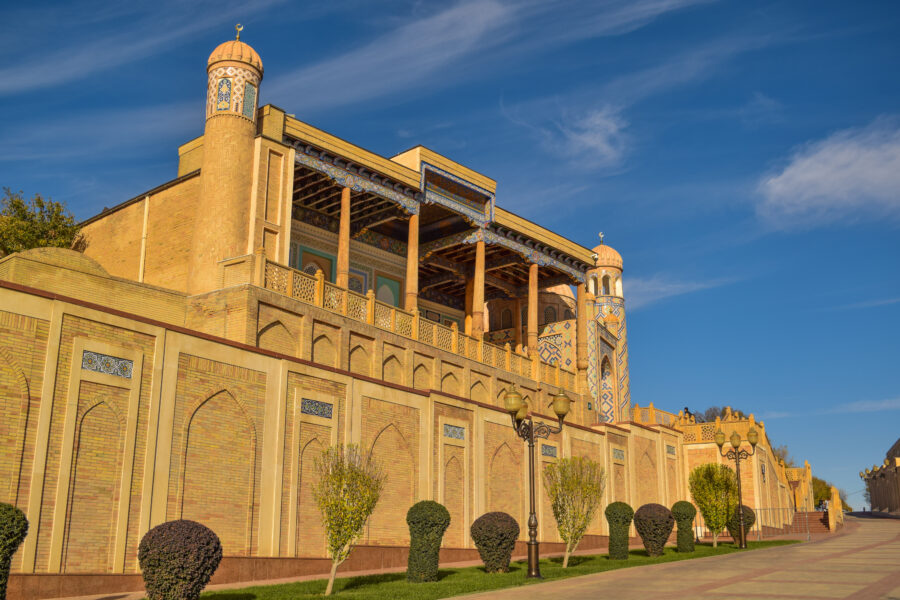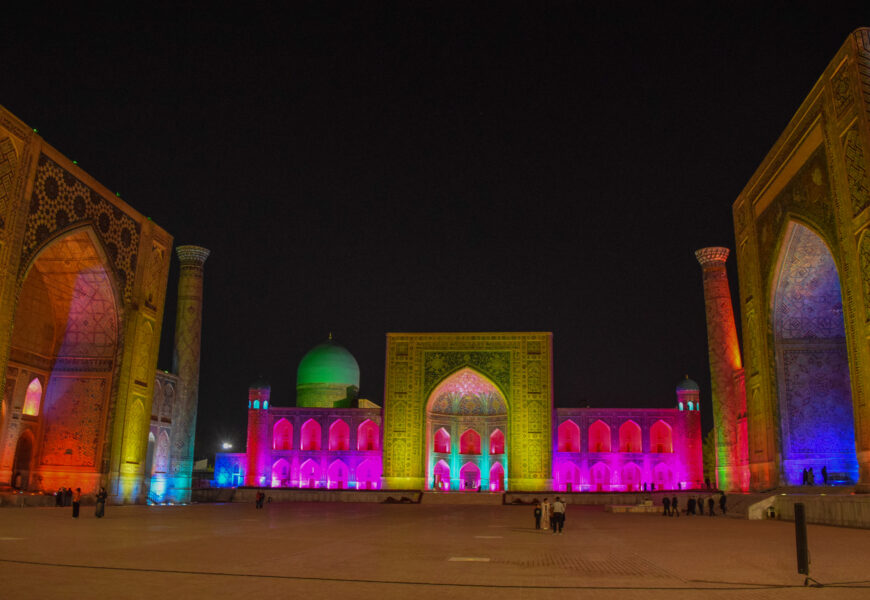Samarkand is a name that conjures up images of adventure, exploration, and far-away mysteries. A city as old as time, Samarkand, was founded in around 700 BCE, one of the oldest continuously inhabited cities in the world, a crossroads of cultures, and a hub of learning and trading – especially during the heyday of the ancient Silk Road, which passed through the city. Every travel enthusiast must have heard of Samarkand, and deep down they all know, that Samarkand is way more than what they have read or heard about it. With its varied sights, including stunning mosques, mausoleums, and madrassas, it certainly is the jewel of Uzbekistan.

For centuries, the city had been a trade center along the Silk Road, and here converged caravans from China, India, and Persia. It remained a highly populated and commercially relevant center until 1220 when the destructive madness of Genghis Khan wiped it from the face of the earth.
Samarkand remained a pile of rubble until 1370 when Timur (Timerlane) decided to rebuild it and make it his capital. He brought in artisans and artists from all over Central Asia and they offered their knowledge to rebuild it and make it not only a commercial but also a cultural epicentre. His nephew Ulugbek built an important astronomical observatory here, with a 30-meter-wide quadrant which is still admired.
In the sixteenth century, the city risked disappearing again. The capital of the empire was moved to Bukhara and Samarkand, after several earthquakes, was almost entirely abandoned. The Soviets, at the end of 1800, injected new life into the city, connecting it to the Trans-Caspian railway network.


An emblem of culture: The first set of monuments
Start your day with the Shah-i-Zinda, and keep Registan square for the evening so that you are in the square when evening lights are lit. The Shah-i-Zinda is an enchanting necropolis hailed as one of the Timurid era’s most magnificent creations. Every tomb along the street is different in its design, and the interiors are often as ornate as the facades. You will find many pilgrims here to pay homage to the tomb of Qutham ibn Abbas, Patron saint of Samarkand and a cousin of Prophet Muhammad. For any traveler, the Shah-i-Zinda serves as an awe-inspiring introduction to Samarkand’s architectural wonders. From the grandeur of Timurid design to the delicate flourishes of later rulers, each structure tells a story of artistic evolution and cultural exchange.
A little further away from the Shah-i-Zinda is the Ulug Bheg observatory. Ulug Bheg, Timur’s grandson, was a Sultan, but also a scientist with a passion for mathematics and astronomy. His work is remembered at the historic Ulug Bheg’s Observatory, which was built in the 1420s on a hill overlooking Samarkand. Today, it showcases the historical measurements of the sun’s path over a year, off by only one minute from today’s measurements.






Head to the President’s Tomb
As you return from there, make a halt at the President’s tomb or the Hazrat Khizr mosque. The resting place of Islam Karimov, the nation’s inaugural President, holds profound significance, providing insights into Uzbekistan’s contemporary narrative and political evolution. The Hazrat Khizr mosque’s exquisite architectural intricacies are complemented by a panoramic viewpoint terrace offering breathtaking vistas of Samarkand.


The many sights in Siab Bazaar
You may cross the footbridge and head to the Siab bazaar. The Siab bazaar may not be as grand and impressive as the Chorsu bazaar of Tashkent, but it’s a cool site to see nonetheless. Perched next to the Bibi Khanym mosque, its central position in Samarkand makes it a bustling hub of activity and a great place to soak in the local sights, sounds, and flavors.

The legend of Bibi Khanyum mosque
The actual treat here is the Bibi Khanyum mosque. According to legend, the Bibi Khanyum Mosque in Samarkand was commissioned by Timur’s beloved wife to commemorate his return from an extensive conquest campaign. Today, it stands as one of the largest mosques in Central Asia, with a capacity to accommodate around 10,000 worshippers at a time. The mosque was said to be financed with the loot stolen during the invasion of India.
It is said that the sheer size of the mosque posed a formidable challenge to the builders, leading to the dome starting to collapse before its completion. Another folktale says that the architect of the mosque fell in love with Bibi Khanyum, who had commissioned the building of the mosque and refused to complete it if he did not get a kiss from Bibi in return. Bibi agreed since she wanted to see the mosque completed. But the kiss was so passionate that it left a mark on Bibi’s face. Despite her efforts to conceal it with a veil, Timur soon discovered her infidelity. Enraged by the betrayal, Timur denounced his wife, ordered the architect’s execution, and mandated veiling for women to prevent further temptation. Legend takes a poignant turn as Bibi, facing banishment, approaches Timur with a large, empty sack. According to tradition, Timur was obliged to grant her a wish. He asked her what she wanted to put in it and Bibi replied: “I want to put you in it since you are the only thing I care about”. This gesture pacified Timur and he forgave his queen.




The beauty and scale of the mosque are testimony to the artistic dexterity of that era. And while you are there, pencil in time to walk across the Promenade street and savor the shopping places. You may go for lunch at the Bibikhanum Teahouse. This outdoor restaurant has its staff serving food in traditional clothing. Or go to the Art gallery ‘Happy Bird’, an authentic art gallery selling ethnic-colored clothing mixed with nowadays designs, and check out some of their products.
“Tomb of the King” Gur-e Amir
Perhaps the architectural prowess of Uzbekis reaches its prowess here in Gur-e-Amir. This architectural marvel is renowned for its intricate tilework, majestic dome, and historical significance as the burial site of Timur and several of his descendants. Stepping into its grandeur feels like stepping back in time, as you’re greeted by the magnificent dome and intricate tilework that adorn its facade. The intricate tile work in gold and turquoise, in the compartment where Timur’s grave lies, can leave you in a click frenzy mode. Wander through the tranquil gardens surrounding the mausoleum, the air here does seem to carry a whiff of history. There are also many souvenir shops around to buy a piece of Uzbek with you. Gur-e Amir promises an unforgettable voyage into Uzbekistan’s rich cultural tapestry.





The indescribable Registan Square
Undoubtedly, the Registan stands as the most iconic monument in Samarkand, and arguably along the entire Silk Road. This imposing square commands the city’s center, flanked by three intricately adorned madrassas, each vying for attention with its exquisite decoration. All tourists visit the Registan during the day, but it is well worth returning to the square after dark. Or probably the best time to pay a visit is the evening when you can capture the contrasts between the day and night shots. This allows you to witness the monument’s transformation under the gentle glow of evening lights. Also, there is a light and sound show in the evening, which makes it worth all the wait.


The Registan square is surrounded by three enormous madrassas that can be spotted from anywhere in the city. The monumental grandeur of these structures remains awe-inspiring, never fading with time. Dating back to the 15th to 17th centuries, the square’s trio of madrassas—Ulugbek Madrassah, Sher Dor Madrassah, and Tilla-Kari Madrassah—stand as epitomes of Islamic architecture. These educational institutions epitomize the essence of the ancient Silk Road, embodying its spirit of scholarship and commerce that once flourished throughout the region.


Savour some local delights
Samarkand is famous for its bread. Don’t be surprised to see people who have come to Samarkand from other cities to buy bread. This is called the obi non, a style of bread that’s freshly made in a clay oven, then stamped and decorated with a spiky tool that can be picked up at any given souvenir stand.
Do savor in plov here, a rice dish that is made with a wide variety of ingredients including carrots, beef, raisins, and onions. In Samarkand, you will find varied versions of plov. Do try achichuk – tomato salad with onions and a hint of chili, with plov for some extra taste. And then there is samsa – samosas with various, but mostly meat fillings – while the ubiquitous shashlik is skewers of various types of meat. And if you find yourself longing for noodles, look no further than Lagman, a popular dish featuring tender noodles accompanied by a flavorful medley of ingredients.








